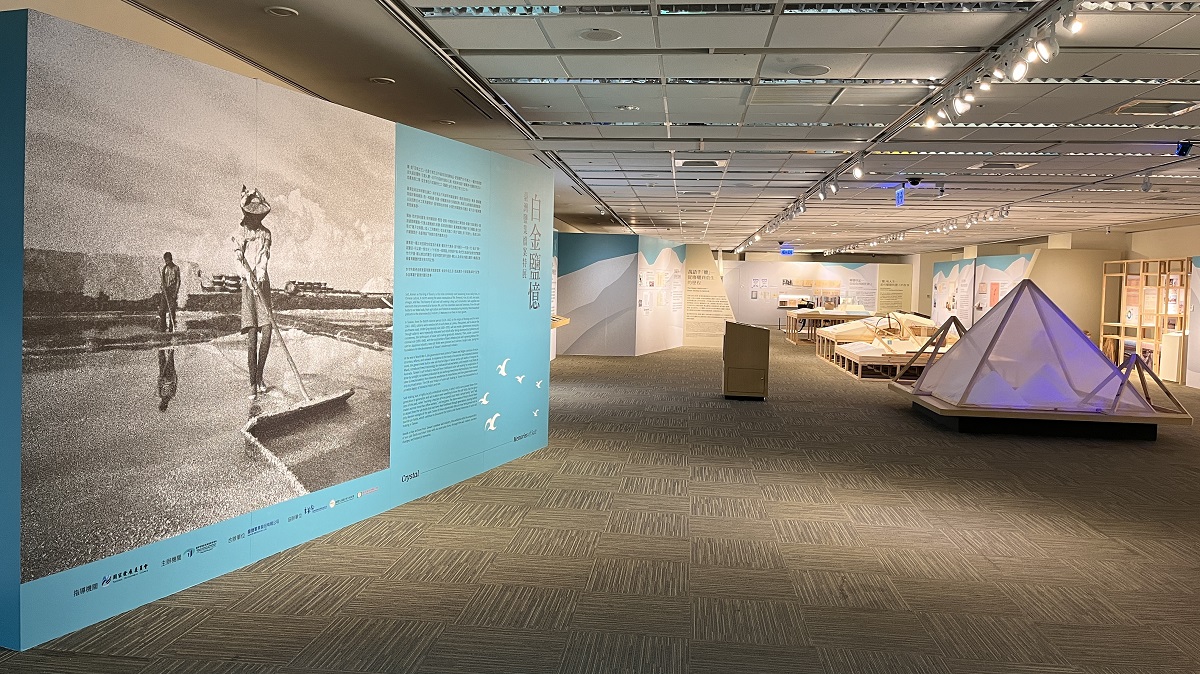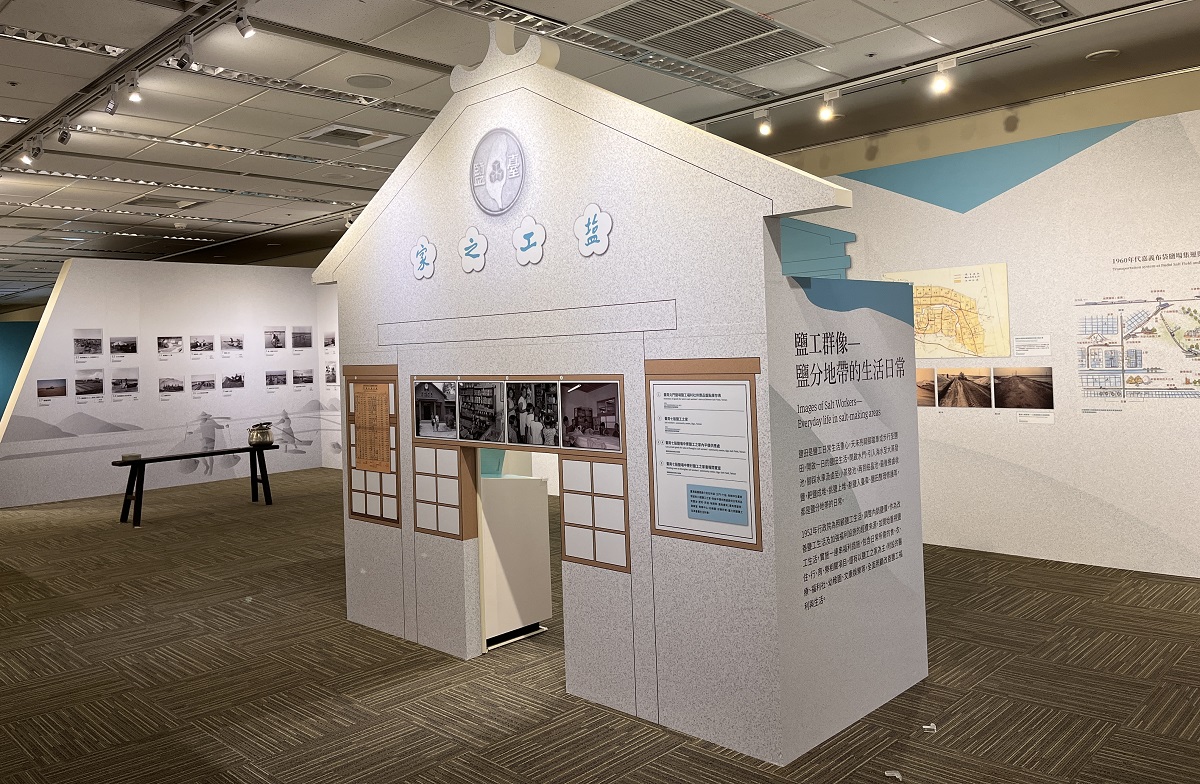Crystal Memories of Salt—An Archival Exhibition on Taiwan’s Salt Industry
發布日期:111.10.19
Salt, known as the king of flavors, is the most commonly used seasoning in our daily lives. In Chinese culture, it counts among the seven necessities of life: firewood, rice, oil, salt, soy sauce, vinegar, and tea. The history of salt and salt making is long and remarkable. Salt supplies two elements that are essential to human life, and has countless uses and functions. From the salt fields to our tastebuds, from agriculture and fisheries to manufacturing industry, from household products to the pharmaceutical industry, it features in our lives in many guises.
In Taiwan, from the Dutch colonial period (1624–1662) to the reigns of Koxinga and his heirs (1661–1683), salterns were constructed at such places as Laikou, Zhouzaiwei, and Ta-kau on the southwest coast. Under Qing-dynasty rule (1683–1895), salt was made a government monopoly. Though salterns were repeatedly relocated and rebuilt after being destroyed by typhoons and rainstorms, the techniques of solar salt making gradually matured. Then, under Japanese colonial rule (1895–1945), with the construction of basic infrastructure and a growing demand for salt for Japanese industry, new salt fields were planned and built on a larger scale, laying the foundations for the development of Taiwan's modern salt industry.
At the end of World War II, the government took control of Taiwan and began a process of reconstruction, reform, and renewal. In response to the needs of economic and industrial development, the government built a new salt field at Qigu in Tainan and a salt works at Tongxiao in Miaoli, introduced French technology for mechanized salt extraction, and invested in salt fields in Australia. Taiwan's salt industry evolved from traditional solar salt making by evaporation of brine by sunlight, to modern production by ion exchange membrane electrodialysis; from manual labor to mechanization; from domestic production to importation; and from government ownership to privatization. The 338-year history of solar salt making in Taiwan has bequeathed us a priceless legacy of industrial history and lore.
Salt making was a highly locally embedded industry, in which skills were passed down from generation to generation and salt makers were unwilling to leave the salt fields. But the glory days of the past, when “working a hectare of brine ponds could feed a whole family” and “salt makers earned more than office workers,” are long gone. The storm waves of history forced them to depart from the salt fields that were their livelihood through generations, leaving behind only derelict vestiges of the past. Some of these abandoned sites are now being preserved as tourist salt fields, which continue to document the history and shared memories of solar salt making in Taiwan.
Based on key archives from Taiwan's postwar salt industry, this exhibition tells the unique story of our salt fields and their links with our everyday lives, through the salt makers, societal changes, and historical memories.
Sectionan 1 The Way Things Were—A Race with the Weather
The landscape of the salt fields is a microcosm of the development of Taiwan’s salt industry. This tangible heritage bears witness to the steadfast spirit and quiet dedication of generations of salt makers. From the changing map of Taiwan's salt fields through history, and from drawings and photographs of salt making facilities, we can get a good understanding of the development timeline of the salt fields and the changes in their topography and configuration over the course of the industry's development.Geographical environments and climatic conditions greatly influenced the development of the traditional salt industry. Subtropical Taiwan has no clearly defined dry season and lies in the path of typhoons. This makes it a less than ideal location for solar salt making, for it is subject to intermittent periods of heavy or torrential rainfall that may dilute the brine in evaporation ponds and wash away the finished salt stored outside in salt mounds. Thus for Taiwan's salt makers, salt making was always a race against the weather.
Sectionan 2 The Wonders of Salt—From Physiology to Industry
The main chemical constituent of salt is sodium chloride, together with small amounts of potassium compounds. Besides its use as a food seasoning, it is the most natural of preservatives, and is widely used in processed foods and for the pickling and preservation of fresh farm produce and seafoods. Salt is also an indispensable basic substance for maintaining electrolyte balance in the bodies of both humans and animals.The chemical industry uses large quantities of crude, processed, and industrial salts as raw materials to produce chemicals such as hydrochloric acid and sodium carbonate. Salt is also widely used in the metallurgy, leather tanning, soap making, and pharmaceutical industries, as well as in agriculture, animal husbandry, and fisheries. Thus salt plays a crucial role both in our everyday lives and in industrial development.
Sectionan 3 Salt of the Earth—Stories of Salt Making and Salt Makers
Sunshine, seawater, wind, salt fields, and people are the most beautiful elements in the development of Taiwan’s salt industry. The salt tax was long an important source of tax revenue in Taiwan. After World War II, the ROC government took possession of the land and assets of Taiwan's salt industry from the Japanese, and promulgated “the Salt Administration Statute”, which provided for government operation of the entire salt industry, from production and shipping to storage and sales. Salt production technology also gradually transitioned from traditional manual methods to mechanized extraction. In the postwar period, in order to improve the lives of Taiwan's salt workers, the government increased the price of salt, making it possible to raise salt workers' wages, improve welfare provision, and provide skills training for reemployment in other trades, thus assuring their basic livelihoods. Buffeted by salty sea winds and toiling come rain or shine, the salt workers created the beauty of the salt fields in mound after mound of snow-white salt. Their tanned bodies and weathered faces bear witness to their unique life and stories as solar salt makers.
Sectionan 4 The Story Continues—From Decline to Rebirth
Facing global competition, from 1982 onward Taiwan Salt Works began to convert its three major salt production areas at Budai, Tainan, and Qigu to fully mechanized salt extraction in order to reduce labor costs and improve product quality. In 1989 it began to diversify its operations, actively seeking to transform itself and develop new salt-based products. In 1993, Taiwan Salt Works was included in the second round of privatizations of state-owned enterprises, first undergoing reorganization and registration as a company—the Taiwan Salt Industrial Corporation (Taiyen)—followed by phased reductions of capital, the return of land holdings in salt producing areas to the government, resolution of issues around the termination of salt workers' employment, and the complete cessation of manual salt making. In 2002, Taiyen ended mechanized salt production, and the government drew up plans for the preservation and sustainable use of the salt fields and related facilities. The history of Taiwan's salt industry, from its earliest origins to its heyday, transformation, decline, and rebirth, is not something that can be told in a few sentences. But by looking at that history from the perspective of the industry’s cultural heritage, we can gain new insights into the topics of sustainable development and how to maintain the legacy of our salt industry's historical culture.
* Xinzhuang Exhibition
2022/10/19 - 2023/08/04
09:00-17:00(closed on holidays)
Exhibition Hall, National Archives Administration, National Development Council
* Tainan Exhibition
2023/10/03 - 2024/07/31
09:00-17:30(closed on CNY’s Eve and typhoon days)
Exhibition Hall, Qigu Salt Mountain, Taiyen Biothch Co., Ltd
* Nantou Exhibition
2024/09/03 - 2025/03/02
09:00-17:00(closed on holidays and Monday)
Taiwan Provincial Administration Information Hall
In addition to hosting the abovementioned exhibitions, NAA also established an
online exhibition system.


